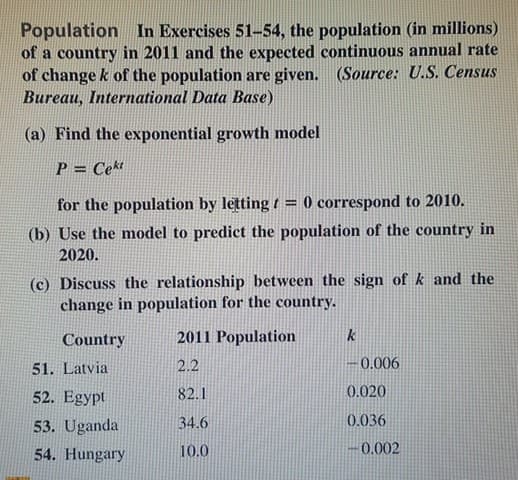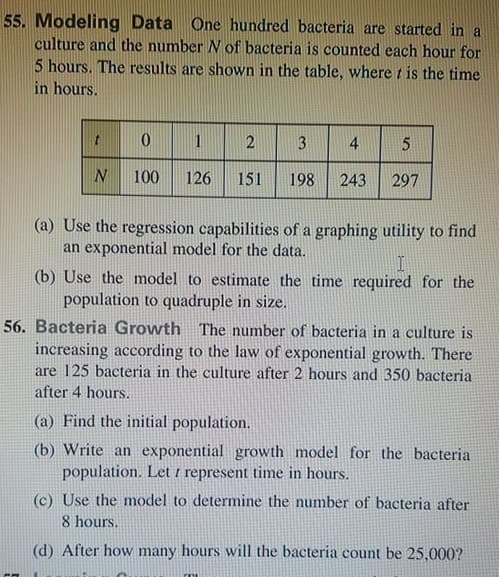Population In Exercises 51-54, the population (in millions) of a country in 2011 and the expected continuous annual rate of change k of the population are given. (Source: U.S. Census Bureau, International Data Base) (a) Find the exponential growth model P = Cekt for the population by letting t = 0 correspond to 2010. (b) Use the model to predict the population of the country in 2020. (c) Discuss the relationship between the sign of k and the change in population for the country. Country 2011 Population k 51. Latvia 2.2 -0.006
Population In Exercises 51-54, the population (in millions) of a country in 2011 and the expected continuous annual rate of change k of the population are given. (Source: U.S. Census Bureau, International Data Base) (a) Find the exponential growth model P = Cekt for the population by letting t = 0 correspond to 2010. (b) Use the model to predict the population of the country in 2020. (c) Discuss the relationship between the sign of k and the change in population for the country. Country 2011 Population k 51. Latvia 2.2 -0.006
Algebra & Trigonometry with Analytic Geometry
13th Edition
ISBN:9781133382119
Author:Swokowski
Publisher:Swokowski
Chapter5: Inverse, Exponential, And Logarithmic Functions
Section5.3: The Natural Exponential Function
Problem 23E
Related questions
Question

Transcribed Image Text:Population In Exercises 51-54, the population (in millions)
of a country in 2011 and the expected continuous annual rate
of change k of the population are given. (Source: U.S. Census
Bureau, International Data Base)
(a) Find the exponential growth model
P = Cekt
%3D
for the population by letting t = 0 correspond to 2010.
(b) Use the model to predict the population of the country in
2020.
(c) Discuss the relationship between the sign of k and the
change in population for the country.
Country
2011 Population
k
51. Latvia
2.2
-0.006
52. Egypt
82.1
0.020
53. Uganda
34.6
0.036
54. Hungary
10.0
-0.002

Transcribed Image Text:55. Modeling Data One hundred bacteria are started in a
culture and the number N of bacteria is counted each hour for
5 hours. The results are shown in the table, where t is the time
in hours.
1
2
3
4
100
126
151
198
243
297
(a) Use the regression capabilities of a graphing utility to find
an exponential model for the data.
(b) Use the model to estimate the time required for the
population to quadruple in size.
56. Bacteria Growth The number of bacteria in a culture is
increasing according to the law of exponential growth. There
are 125 bacteria in the culture after 2 hours and 350 bacteria
after 4 hours.
(a) Find the initial population.
(b) Write an exponential growth model for the bacteria
population. Let i represent time in hours.
(c) Use the model to determine the number of bacteria after
8 hours.
(d) After how many hours will the bacteria count be 25,000?
Expert Solution
This question has been solved!
Explore an expertly crafted, step-by-step solution for a thorough understanding of key concepts.
This is a popular solution!
Trending now
This is a popular solution!
Step by step
Solved in 4 steps

Knowledge Booster
Learn more about
Need a deep-dive on the concept behind this application? Look no further. Learn more about this topic, calculus and related others by exploring similar questions and additional content below.Recommended textbooks for you

Algebra & Trigonometry with Analytic Geometry
Algebra
ISBN:
9781133382119
Author:
Swokowski
Publisher:
Cengage

College Algebra
Algebra
ISBN:
9781305115545
Author:
James Stewart, Lothar Redlin, Saleem Watson
Publisher:
Cengage Learning

Trigonometry (MindTap Course List)
Trigonometry
ISBN:
9781337278461
Author:
Ron Larson
Publisher:
Cengage Learning

Algebra & Trigonometry with Analytic Geometry
Algebra
ISBN:
9781133382119
Author:
Swokowski
Publisher:
Cengage

College Algebra
Algebra
ISBN:
9781305115545
Author:
James Stewart, Lothar Redlin, Saleem Watson
Publisher:
Cengage Learning

Trigonometry (MindTap Course List)
Trigonometry
ISBN:
9781337278461
Author:
Ron Larson
Publisher:
Cengage Learning



Functions and Change: A Modeling Approach to Coll…
Algebra
ISBN:
9781337111348
Author:
Bruce Crauder, Benny Evans, Alan Noell
Publisher:
Cengage Learning